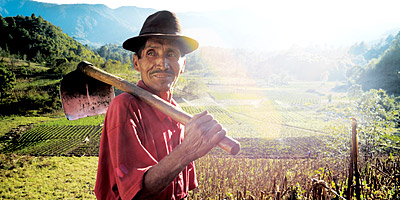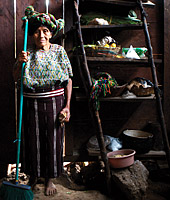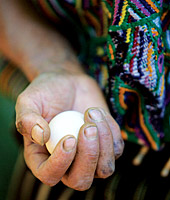Living in Hope
Can we eliminate
extreme poverty
in our lifetime?

Diego, a farmer living in the Agros Guatemala village La Esperanza, returns from a day spent working in the community's fields. In partnership with Agros, a Seattle-based NGO, he is working to own his own land.
By Lisa Donegan, SPU Instructor of International Business
Photos by Ira Lippke
“Millions of people die every year for the stupid reason they are too poor to stay alive. ... That is a plight we can end.”
—Jeffrey Sachs, General Assembly of the United Nations
Tears welled in her eyes and her clear voice trembled as Theresa spoke to
a group of strangers, friends, and family huddled together on a small porch of the Agros Guatemala office on a cold, rainy November evening in Cotzal, Guatemala. Except for an occasional mi familia and a Dios, and many gracias, I couldn’t understand her; I don’t speak Spanish. Her parents — who speak Ixil, a Mayan language — couldn’t understand her either. But we all understood the emotions behind the words: gratitude for the sacrifices of her family and the generosity of foreign strangers; relief at having passed her last arduous exams; sadness as goodbyes to professors and classmates loomed; and uncertainty about what the future held.

This Guatemalan woman makes her home in the Agros village of El Paraiso. |
Theresa was one of five students graduating from the
University of the Valley of Guatemala, thanks particularly to the support from three nongovernmental organizations (NGOs): Agros International, Fundación Agros, and Women’s Enterprise International. I was part of a group of American women who were there to help celebrate this rite of passage, a tangible result of many choosing to live in hope,
sharing in faith a vision of a more prosperous future for this
once war-torn country.
As a trained economist, I am more at ease in a classroom, expounding about economic theories and models of the benefits of free trade and economic growth and development. I approach the issue of global development from a quantitative perspective: gross domestic product (GDP) growth rates, GDP per capita, unemployment rates, literacy rates, HDI rankings, life expectancy rates. But I was grateful for the opportunity to go beyond the figures and meet individuals whose rising incomes translate into rapidly changing lives.
The theme of this year’s Seattle Pacific University Day of Common Learning, which featured world-renowned theologian of hope Jürgen
Moltmann, was “Living in Hope.” This gave me
the perfect opportunity to organize a panel of experts to discuss the thesis of one of my favorite books: Jeffrey Sachs’ The End of Poverty: Economic Possibilities for Our Time. I titled the session
“Eliminating Extreme Poverty in Our Lifetime: Impossible Dream or Attainable Goal?”
“We can be the generation,” writes Sachs, “that can see the end of extreme poverty in our lifetime.” Sachs defines extreme poverty as those living on less than $1 a day. This is not the type of poverty found in the developed world, although we too have poverty issues to address, and it is not even a measure of those living below a country-
specific poverty line. These are the 20,000 people a day, Sachs writes on page one of his book, who die because “they are too poor to stay alive.”
Sachs’ optimism about eliminating extreme poverty — a holy grail that has been sought by many a generation — comes in part, ironically, from the widening gap between rich and poor countries. “As of 1820,” he writes, “the biggest gap between rich and poor — specifically, between the world’s leading economy of the day, the United Kingdom, and the world’s poorest region, Africa — was four to one in per capita income. … By 1998, the gap between the richest economy, the United States, and the poorest region, Africa, had widened to twenty to one.”
This vast chasm between today’s rich and poor countries, Sachs explains, radically transforms the amount of development aid that is needed into a far smaller percentage of income transfer capable of lifting the poorest economies out of the poverty trap and onto the first rung of the ladder of economic development.

Agros International partners with families in the Americas to end poverty within their communities. |
Another source of his optimism is the signed commitment of 191 countries to the United Nations’ Millennium Development Goals. These eight goals, representing an unprecedented global commitment to the eradication of extreme poverty at the beginning of the 21st century, target specific strategies to combat the most exacerbating causes of poverty.
The Millennium Development Goals include eradicating extreme poverty and hunger, setting a deadline of 2015 (just eight years from now) to cut in half the number of people living on less than $1 a day; achieving universal primary education; promoting gender equality and empowering women, which has a dramatic impact on fertility and poverty rates; reducing child mortality; improving maternal health; combating HIV/AIDS, malaria, and other diseases; ensuring environmental sustainability; and developing a global partnership for development. The responsibility for achieving these goals rests not only on government action, but also on contributions from the private sector, including individuals, for-profit corporations, and NGOs.
For my panel of experts on the Day of Common Learning,
I tapped into the bevy of development NGOs that call Seattle home. Accepting
my invitation to speak were Paul Kennel, president of Dime Foundation and former president of World Concern; Gena Morgan, special initiatives officer at PATH; and Christina Cummings, international program assistant at Agros International. At both one-hour sessions, SPU students, staff, and faculty packed a McKenna Hall classroom, spilling out into the hallway.
Paul shared from a wealth of experiences accumulated over decades of serving God through his missionary, aid, and development work. His clear message: Each one of us has “extra” that we can use to make a
difference. Gena highlighted the changing patterns of world health and how PATH’s work developing simple health care technologies is saving lives. Christina used audience participation to illustrate the obstacles Agros faces in dissemination of new agricultural techniques and crop diversity.
At the end of our second hour-long presentation, a voice
rose from a corner of the room. “Has anyone here heard of
The 37five Project?” The speaker identified himself as Matthew Koenig, Seattle Pacific’s associate director of university ministries. Answering his own question, he said, “The 37five Project
is designed to empower SPU undergraduates to fund their own selected development projects. Through the Office of University Ministries and Center for Worship at Seattle Pacific, students will invest $37,500 — 100 grants of $375 — this year in local and international organizations doing God’s work in the world.”
Koenig’s closing challenge to the students sent chills down my spine. “With 100 ‘37fives,’ next year we will hear 100 more stories of how God is using SPU students to help alleviate extreme poverty.” Living in hope, indeed.
In a presentation for this year’s Day of Common Learning, Seattle Pacific University Instructor Lisa Donegan asked whether ending extreme poverty in our lifetime is an “impossible dream” or an “attainable goal.”
Return to top
Back to Features Home
|